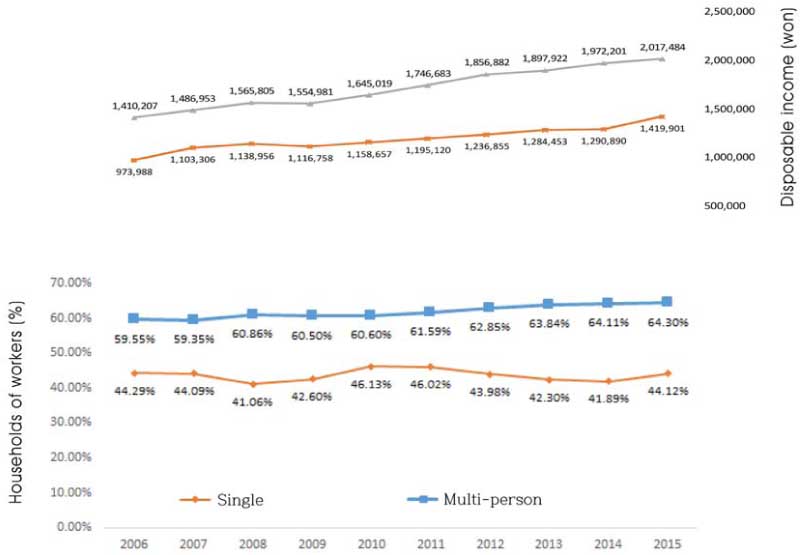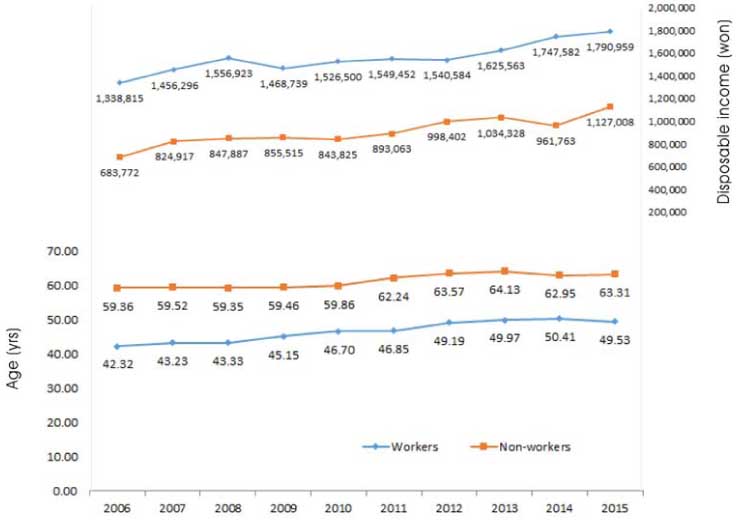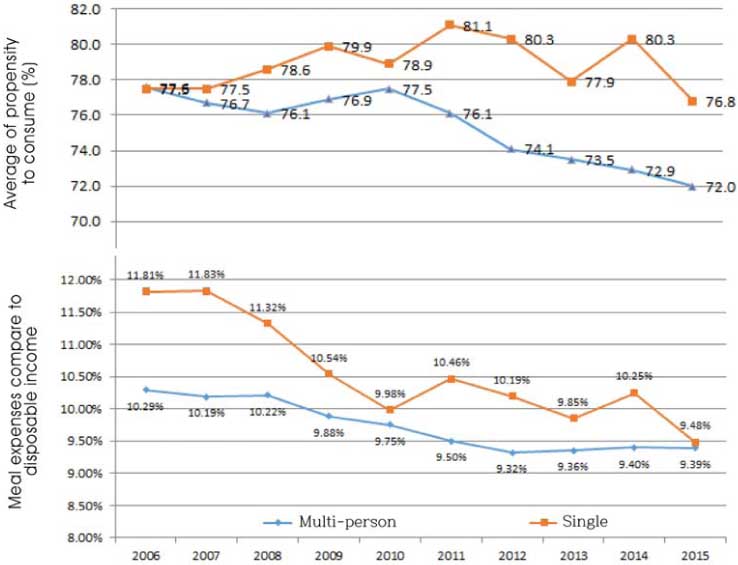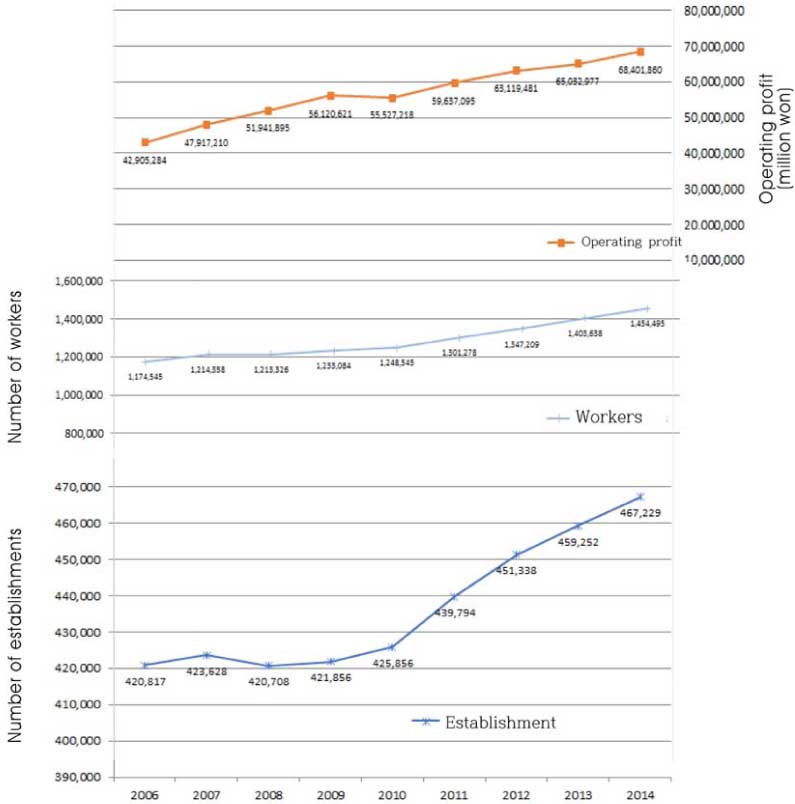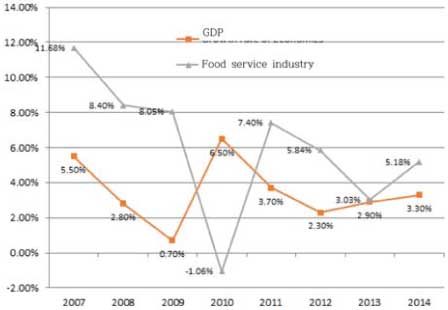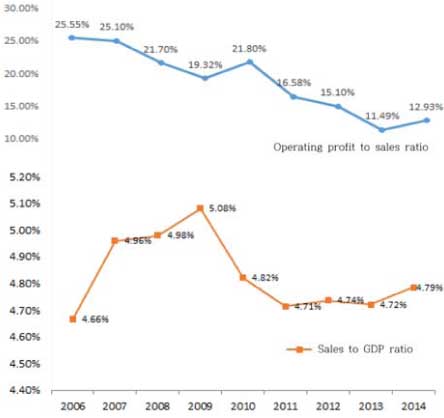Korean J Community Nutr.
2016 Aug;21(4):321-331. 10.5720/kjcn.2016.21.4.321.
The Effects of the Economic Characteristics of Single-person Households on the Food Service Industry
- Affiliations
-
- 1Department of Economics, Hanbat National University, Daejeon, Korea. jopk@hanbat.ac.kr
- KMID: 2351702
- DOI: http://doi.org/10.5720/kjcn.2016.21.4.321
Abstract
OBJECTIVES
The purpose of this study was to examine the economic characteristics of single-person households and explain the effects of them on the food service industry.
METHODS
For this paper, I analysed the data related with single-person households and the food service industry in two surveys, Household Income and Expenditure Survey and Wholesale and Retail Trade Survey published by Statistics Korea from 2006 to 2015, with an empirical test performed utilizing these data. The indicators of the age of householders, disposable income per capita, and the rate of household of worker were compared between single and multi-person households. Furthermore, sales and the number of establishments in the food service industry were used as industry-variables, and disposable income, eating-out expenses and the rate of single-person households as the household-variables were used in a panel analysis.
RESULTS
The results showed that household incomes were lower, age of householder was higher, and the percentage of household of worker was lower in single-person households in contrast to multi-person households. According to the empirical analysis, eating-out expenses of single-person households, in comparison to multi-person households, has significantly positive effects on the growth of the food service industry. This means that the recent trend of increasing numbers of single-person households may help the growth of the food service industry.
CONCLUSIONS
The growth in the rate of single-person households has been one of the most striking demographic shifts in recent decades. Their economic characteristics and the effects were analyzed to give the managers in the food service industry and the policy-makers useful information in dealing with this new trend. Moreover, in considering the fact that single-person households eat out more frequently than multi-person households, the food service business should develop the managerial strategies focused on acclimatizing to single-person households.
Figure
Cited by 2 articles
-
Energy intake from commercially-prepared meals by food source in Korean adults: Analysis of the 2001 and 2011 Korea National Health and Nutrition Examination Surveys
Injoo Choi, Won Gyoung Kim, Jihyun Yoon
Nutr Res Pract. 2017;11(2):155-162. doi: 10.4162/nrp.2017.11.2.155.Food consumption behaviors of women by marital status: focus on the 2015 consumers survey data on food consumption behaviors
∗
Eun-kyung Kim, Se-Young Ju
J Nutr Health. 2018;51(2):168-176. doi: 10.4163/jnh.2018.51.2.168.
Reference
-
1. Statistics Korea. Statistical Terms [Internet]. 2016. cited 2016 May 27. Available from: http://kostat.go.kr/portal/eng/resources/4/detail_lang.action?bmode=detail_lang&pageNo=1&type=class&cls=O&list_no=230.2. Davos 2007: Labour and the Shifting Power Equation. Statement of Labour Leaders to the World Economic Forum Annual Meeting (Davos, 24-28 January 2007) [Internet]. 2007. cited 2016 May 28. Available from: http://www.tuac.org/en/public/e-docs/00/00/01/A0/document_doc.phtml.3. Statistics Korea. Household Income and Expenditure Survey (New Classification) every year [Internet]. 2016. updated 2015 May 27. cited 2016 May 27. Available from: http://kosis.kr/statHtml/statHtml.do?orgId=101&tblId=DT_1L9F028&conn_path=I2.4. Kim DH. An analysis on living condition influenced by the determinants of growth of single youth households and government policy. In : Proceedings of 2012 Annual Conference of the Korean Association for Local Government Studies; 2012 Nov 9; Seoul. p. 1–27.5. Kim HS. The role of family, government and society for old age guarantee. In : KDI Focus; 2015 Mar; p. 1–8.6. Statistics Korea. 2010 Report on the social survey. Daejeon: Statistics Korea;2010.7. Lee SS. The 2015 national survey on fertility and family health and welfare. In : Korea Institute for Health and Social Affairs; 2015 Dec; Report No. 2015-31.8. Statistics Korea. 2015 the aged statistics. 2015. updated 2015 Sep 14. cited 2016 May 10. Available from: http://kostat.go.kr/portal/korea/kor_nw/2/1/index.board?bmode=read&aSeq=348565.9. Joo JS, Moon YK, Kim YT, Kim YR, Song CS, Lim YG, et al. Korean Longitudinal Survey of Women & Families. In : Korean Women's Development Institute; 2015 Dec; Report No. 20.10. Chang HK, Hwang KI, Choi IH, Kim YR, Joo JS, Kim SY, et al. An analysis on the Korean family status survey 2015. In : Ministry of Gender Equality and Family; 2015 Dec; Report No. 2015-65.11. Statistics Korea. Projected households by age, type and size. 2014. updated 2014 Jan 14. cited 2016 May 10. Available from: http://kosis.kr/statisticsList/statisticsList_01List.jsp?vwcd=MT_ZTITLE&parentId=A#SubCont.12. Kang EN, Lee MH. Single-person households in South Korea and their policy implication. Health Welf Policy Forum. 2016; 234:47–56.13. Lee KI, Hwang YJ, Ban HJ, Lim SJ, Jin HJ, Lee HS. Impact of the growth of single-person households on the food market and policy task. In : Korea Rural Economic Institute; 2015 Oct; Report No. R762.14. Han JM, Lee YH. An analysis on the influence of the growth of single households on consumers' expenditure. KIET Ind Econ. 2013; (6):22–31.15. Seo JJ. The growth of solo economy and the financial industry. In : KB Research Institute; 2013 Mar.16. Lee EM. The Characteristics and implications of single households from the perspective of the statistics of population and familybudget. SERI Econ Focus. 2013; 422:1–10.17. Chung KH, Nam SH, Chung EJ, Lee JH, Lee YK, Kim JS, et al. Policy implications of changes in family structure: focused on the increase of single person households in Korea. In : Korea Institute for Health and Social Affairs; 2012 Dec; Report No. 2012-47-25.18. Byun MR, Choi JW, Park MJ, Lee HJ, Kim JA. A study on the policy of Seoul Metropolitan Government for single households. In : The Seoul Institute; 2015 Feb; Report No. 2014-ER-27.19. Ministry of Health and Welfare. 2014 Korean National Health and Nutrition Examination Survey [Internet]. 2015. cited 2016 May 27. Available from: https://knhanes.cdc.go.kr/knhanes/index.do.20. Lee HY, Noh SC, Choi EY. Growth pattern and spatial distribution of one-person households by socio-economic demographic characteristics. J Korean Geogr Soc. 2011; 46(4):480–500.21. Kim HJ. An analysis of household debt burden by householder's occupation. Soc Welf Policy. 2004; 20:109–131.22. Kim JY, You SD. The effects of household characteristics on housing tenure choice and house type. Hous Stud Rev. 2013; 21(4):61–85.23. Lee KA, Chung EC. Residential mobility and housing tenure choice decisions of older homeowners: impacts of gender-specific characteristics of household heads. Hous Stud Rev. 2014; 22(3):127–156.24. Park KS, Kim MS. The impact of change in household living arrangements on the changes in poverty rate among elderly people in South Korea. Korean J Sociol. 2016; 50(1):221–253.25. Jun SM. Spending pattern types and their determinants for oneperson households in Korea. J Consum Policy Stud. 2013; 44(3):21–43.26. Lee SL. The effect of household demographic trend of food expenditure pattern. J Consum Cult. 2014; 17(3):85–104.27. Yoon DH, Chae SA, Song ET. A survey on single households: 2014 vs. 2015 Tracking Survey. In : Embrain; 2015 Mar; Report No. TK_201503_TR_1141.28. Statistics Korea. Statistical database [Internet]. 2016. cited 2016 May 27. Available from: http://kosis.kr/statisticsList/statisticsList_01List.jsp?vwcd=MT_ZTITLE&parmTabId=M_01_01.29. Kim SA, Choe JS, Joung HJ, Chang MJ, Kim Y, Lee SE. Comparison of the distribution and accessibility of restaurants in urban area and rural area. J Nutr Health. 2014; 47(6):475–483.30. Statistics Korea. Korean Standard Classification of Industry [Internet]. 2016. cited 2016 May 27. Available from: https://kssc.kostat.go.kr/.31. Kim GS. The economic characteristics and implications of single households. In : Hyundai Research Institute; 2015 Aug; Report No. 15-33(Vol. 654).32. Korean National Assembly forum. Korean economy, deflation or long-term recession. 2015.33. Kim SW, Kim BR, Kim YJ, Jun IS. A study on improving competitiveness of the food service industry. In : Korea Rural Economic Institute; 2014 Dec; Report No. R741.34. Lee EJ. The direction of policy on the food service industry. In : Proceedings of 2011 Annual Conference of the Korean Food Service Association; 2011 Nov 26; p. 54–76.35. National Tax Statistics. 2015 National Tax Statistics Yearbook [internet]. 2016. cited 2016 May 27. Available from: http://stats.nts.go.kr/data/data_view.asp?idx=1082.36. Park HW, Na K. Study on restaurant franchise service reflected on a single household consumer patterns: focus on 2030 generation. J Digit Des. 2015; 15(3):697–704.37. Park JH, Lee SH, Han SH. An analysis on expenditure pattern on cultural consumption of single households. In : Korean Institute for Industrial Economics & Trade; 2015 Jun; Report No. 2015-376.
- Full Text Links
- Actions
-
Cited
- CITED
-
- Close
- Share
- Similar articles
-
- Analysis of the Difference in Nutrients Intake, Dietary Behaviors and Food Intake Frequency of Single- and Non Single-Person Households: The Korea National Health and Nutrition Examination Survey (KNHANES), 2014–2016
- Diabetes Nutritional Management for Single-Person Households
- Relationship between Eating Behavior and Healthy Eating Competency of Single-Person and Multi-Person Households by Age Group
- Diabetes Self-Management in Vulnerable Populations
- Comparison of Eating Habits and Behaviors of Young Single-Person Households based on Food-Related Lifestyle

